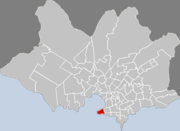Plaza Zabala

Plaza Zabala is a plaza in the Ciudad Vieja of Montevideo, Uruguay. In late 1878, during the dictatorship of Colonel Lorenzo Latorre, it was decided to demolish the old fort and build a public square in its place. But for 12 years this site remained a wasteland. The Plaza finally came to be established only on December 31, 1890 when the equestrian statue of Bruno Mauricio de Zabala was installed. It was sculpted by the Spanish sculptor Lorenzo Coullaut Valera in collaboration with the Basque architect Pedro Muguruza Otaño and inaugurated on December 27, 1931.
The Plaza also now takes its name from Bruno Mauricio de Zabala, founder of the city. The monument has an oblique plan. This layout is distinctly different in an area which has streets laid in a checkerboard pattern in the historic district, marked by the gardens designed by the landscape architect French Eduardo André. It is also one of the places where fences and gates of iron are still seen in the city. The street surrounding the square is named as Ring Durango, in honor of the town Vizcaya of Durango, where Zabala was born. On its south side, Palacio Taranco, once residence of the Ortiz Taranco brothers, is now the Museum of Decorative Arts, and on its west, the well-preserved ex-residence of Sáenz de Zumarán is now the seat of the Discount Bank.[1]
References
- ^ "Acerca de patrimonios varios : DEMOLICION EN LA PLAZA ZABALA".
External links
- Plaza Zabala - IMM
- Monument to M.d.Zabala - IMM
External links

- v
- t
- e
- Peatonal Sarandí
- Peatonal Pérez Castellano
- Rambla 25 de Agosto & Rambla Francia


- Plaza Independencia
- Plaza Constitución
- Plaza Zabala
- Artigas Mausoleum
- Gateway of The Citadel
- Bruno Mauricio de Zabala
- Iglesia Matriz
- Parroquia San Francisco de Asís
- Iglesia de Lourdes
- Templo Inglés
- Executive Tower
- Solís Theatre
- Palacio Taranco
- Club Uruguay
- Casa de Francisco Gómez (Junta Departamental)
- Hotel Colón
- Casa Central del Banco República
- Mercado del Puerto
- Dirección Nacional de Aduanas
- Palacio Estévez
- Municipal Historic Museum and Archive (Cabildo)
- Museo de Artes Decorativas
- Museo Histórico National
- Museo Romántico
- Museo de Arte Precolombino e Indígena
- Museo Torres García
- Museo Figari
- Museo Gurvich
- Sala de Arte "Carlos Federico Sáez"
- Museo del Carnaval
- Radisson Montevideo Victoria Plaza Hotel
- Hotel Palacio
34°54′28″S 56°12′29″W / 34.90778°S 56.20806°W / -34.90778; -56.20806
 | This Montevideo-related article is a stub. You can help Wikipedia by expanding it. |
- v
- t
- e












 Plaza_Zabala
Plaza_Zabala